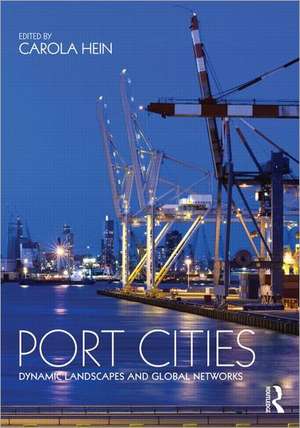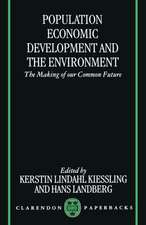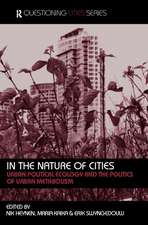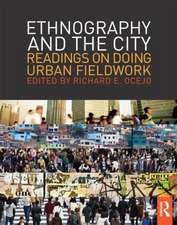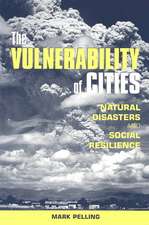Port Cities: Dynamic Landscapes and Global Networks
Editat de Carola Heinen Limba Engleză Paperback – 9 iun 2011
Port Cities brings together original scholarship by both well-published and younger scholars from multiple disciplines and builds upon long-standing research on the international exchange of architectural and planning ideas. A carefully selected series of essays examines comprehensively and globally the changing built and urban environment of selected port cities. They explore similarities, dissimilarities, and how sea-based networking has influenced urban landscapes and architecture, socio-economic and cultural development from the nineteenth to the twenty-first centuries.
The first section examines global networks linking ports and cities and explores the effect of inter-continental transfers on architecture and planning. The second part focuses on interconnected port cities in regional contexts, analyzing socio-economic structures and urban and built form. The third section examines the built environment of selected cities in view of their response to changing technology, transforming socio-economic networks and political contexts, as well as evolving design concepts. Overall, the book proposes a networked analysis of the built and urban environment, arguing that international maritime networks are paradigmatic for the creation of dynamic, multi-scaled, and interconnected "port cityscapes."
| Toate formatele și edițiile | Preț | Express |
|---|---|---|
| Paperback (1) | 341.19 lei 6-8 săpt. | |
| Taylor & Francis – 9 iun 2011 | 341.19 lei 6-8 săpt. | |
| Hardback (1) | 992.25 lei 6-8 săpt. | |
| Taylor & Francis – 9 iun 2011 | 992.25 lei 6-8 săpt. |
Preț: 341.19 lei
Preț vechi: 395.77 lei
-14% Nou
Puncte Express: 512
Preț estimativ în valută:
65.31€ • 70.96$ • 54.89£
65.31€ • 70.96$ • 54.89£
Carte tipărită la comandă
Livrare economică 21 aprilie-05 mai
Preluare comenzi: 021 569.72.76
Specificații
ISBN-13: 9780415780438
ISBN-10: 0415780438
Pagini: 304
Ilustrații: 2 tables and 104 halftones
Dimensiuni: 174 x 246 x 15 mm
Greutate: 0.59 kg
Ediția:1
Editura: Taylor & Francis
Colecția Routledge
Locul publicării:Oxford, United Kingdom
ISBN-10: 0415780438
Pagini: 304
Ilustrații: 2 tables and 104 halftones
Dimensiuni: 174 x 246 x 15 mm
Greutate: 0.59 kg
Ediția:1
Editura: Taylor & Francis
Colecția Routledge
Locul publicării:Oxford, United Kingdom
Public țintă
Postgraduate and UndergraduateCuprins
1. Changing Urban Patterns in Port Cities: History, Present, and Future Part I: Port Cities: Global Networks and Urban Form 2. Migration, Trade and the Atlantic Port Cities 3. Shipping Chinatowns and Container Terminals 4. Seaport Cities 5. Port Cities and the Global Exchange of Planning Ideas Part 2: Regional Dynamics of Port Cities: Politics, People and the Built Environment 6. Trade, Politics and City Space(s) in Mediterranean Ports 7. Mercantile Elites in the Ports of Amsterdam and Rotterdam 8. Treaty Ports of China 9. Staring at the Sea, Staring at the Land 10. Town Planning, Architecture, and Migration in the Port Cities of the Suez Canal Area Part 3: Landscapes of the Port City: Global case studies 11. Hamburg's waterfront redevelopment 12. New York City: How its Port Shaped Its Architecture 13. Hong Kong: Transformative Image as a Port City 14. Dubai’s Jebel Ali Port: Trade, Territory and Infrastructure 14. Conclusions: Patterns of Global Architecture in Port Cities
Notă biografică
Carola Hein is Professor at Bryn Mawr College (Pennsylvania) in the Growth and Structure of Cities Department. Her current research interests include the transmission of architectural and urban ideas along international networks, focusing specifically on port cities and the global architecture of oil.
Recenzii
"Port Cities offers a far richer perspective on the subject of port city development than many other books. Indeed, for those familiar with the large body of literature that covers the fall and rise of the urban waterfront since the advent of the shipping container, this book will come as a breath of fresh air." – Journal of the American Planning Association
"Port Cities offers a far richer perspective on the subject of port city development than many other books. Indeed, for those familiar with the large body of literature that covers the fall and rise of the urban waterfront since the advent of the shipping container, this book will come as a breath of fresh air." – Journal of the American Planning Association
"...as [Port Cities] deals with various geographies, the articles in the collection examine a long time span that enables the reader to see the historical continuities in the port cities it describes. In short, it deliberately exemplifies the dynamic, multi-scaled, and inter-connected port cityscapes created by historical and present-day international maritime networks." - New Perspectives on Turkey
"...a well-documented and illustrated set of chapters that takes the reader literally around the world" - Journal of Urban History
"Port Cities offers a far richer perspective on the subject of port city development than many other books. Indeed, for those familiar with the large body of literature that covers the fall and rise of the urban waterfront since the advent of the shipping container, this book will come as a breath of fresh air." – Journal of the American Planning Association
"...as [Port Cities] deals with various geographies, the articles in the collection examine a long time span that enables the reader to see the historical continuities in the port cities it describes. In short, it deliberately exemplifies the dynamic, multi-scaled, and inter-connected port cityscapes created by historical and present-day international maritime networks." - New Perspectives on Turkey
"...a well-documented and illustrated set of chapters that takes the reader literally around the world" - Journal of Urban History
Descriere
Ports have been and continue to be critical in not just the global movement of goods, but also the global movement of ideas, social change and cultural phenomena including architecture and urban form. Multiple forces are at play: technological requirements, elite preferences and working class needs, urban policy and globalization. Scholars from multiple disciplines explore similarities, dissimilarities and the ways in which sea-based networking influences urban landscapes and architecture, socio-economic and cultural development from the nineteenth to the twenty-first centuries.
